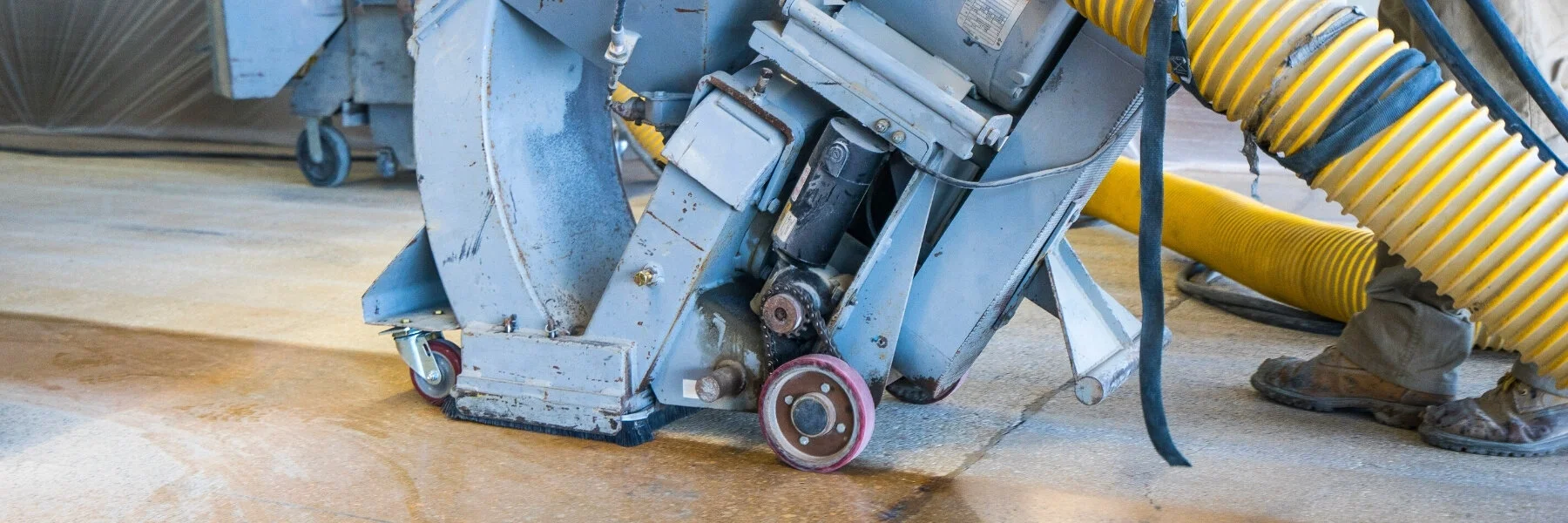Surface Preparation: Shot Blasting
Shot Blasting is a cost effective and environmentally friendly method for preparing concrete substrates. Shot Blasting machines come in a variety of different sizes to match the job at hand. Shot Blasting provides the perfect profile for adhesion to concrete substrates and is a recognized method of preparation by most product manufacturers. Shot Blasting equipment can provide CSP profiles from 3 to 8 depending on the size shot used and the speed setting on the machine.
A DEEP DIVE INTO SHOT BLASTING EQUIPMENT
Shot blast equipment has been around a long time. The first piece of equipment was created by Benjamin Chew Tilghman in 1870. I am sure the first piece of shot blast equipment looked nothing like the machines we use today! I am always impressed when I walk onto one of our job sites and we have multiple shot blasters with their dust collection units all wired up and running.
Today’s shot blast equipment ranges from 8”, 10”, 15”, 20”, 30” and 48” machines that can produce finished floor preparation from 250 square feet per hour to 20,750 square feet per hour. It is very important to find the correct size machine that fits the size project you are wanting to shot blast. Some projects may require multiple machines in different sizes because of the way the rooms are configured in the building. For example, we will utilize a 30” machine in a large, wide open room and a 10” or 15” machine in smaller rooms so we can easily maneuver around the space. Then we run an 8” machine around the perimeter walls to edge prep.
Link to Blastrac Shot Blasting Machine: https://www.blastrac.com/machines/shot-blasting/
PART 1: THE BLAST HEAD
When we talk about shot blast equipment we often forget that this piece of equipment is actually two pieces of equipment. The blast head contains the centrifugal wheel that propels steel shot at a high velocity in a controlled pattern and direction. This creates the blast pattern. The size of the steel shot being propelled onto the concrete or steel surface combined with the speed of the machine will determine the blast profile. The blast profile can range from a CSP 3 (small shot), CSP 4-5-6 (medium to large shot), all the way to CSP 7-8 (large shot). Due to the nature of the process, there are multiple wear parts on a blast head. These wearparts include the centrifugal wheel and liners.
PART 2: THE DUST COLLECTION UNIT
The dust collection unit is just as important as the blast head. In fact, without the dust collection unit the blast head will not work properly. The dust collection unit minimizes dust borne air particles that are generated when the steel shot hits the concrete or steel surface. The dust is first sucked into a HEPA filtration system. Then put through a pulse system that shakes the dust and debris into a bag for easy disposal. The dust collection unit also provides a built-in air wash separation system that removes the dust and debris from the steel shot. This allows the steel shot to be reused in the process.
CLOSING
There is not a more widely used piece of equipment being used to prepare concrete and steel surfaces. Amazingly, there have not been many changes to the blast head itself. However, the dust collection units have changed. They now have much better filtration systems, including HEPA filters for a safer work environment. They also feature easier collection methods, like the new bagging process instead of heavy, bulky, dust pans.
Do you want to learn more about flooring preparation? Check out the full flooring preparation blog post here: https://www.twhicksinc.com/blog/blog/the-critical-nature-of-surface-preparation-1


